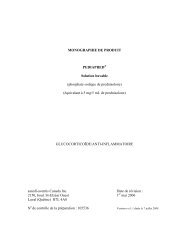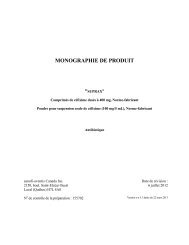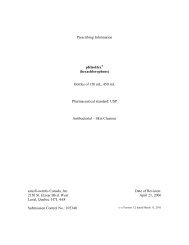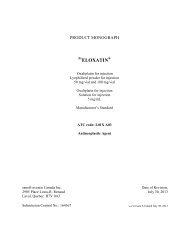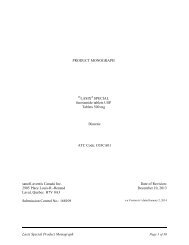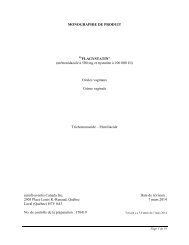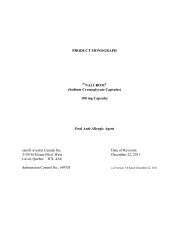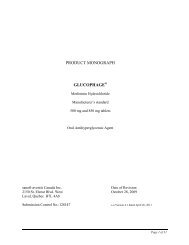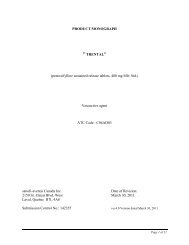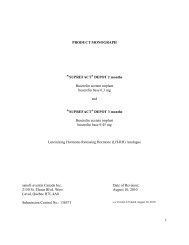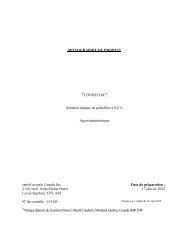Rythmodan (disopyramide) - Sanofi Canada
Rythmodan (disopyramide) - Sanofi Canada
Rythmodan (disopyramide) - Sanofi Canada
- No tags were found...
You also want an ePaper? Increase the reach of your titles
YUMPU automatically turns print PDFs into web optimized ePapers that Google loves.
PRODUCT MONOGRAPHPrRYTHMODAN ®(Disopyramide capsules, BP, 100 mg and 150 mg)Antiarrhythmic AgentATC code: C01BA03sanofi-aventis <strong>Canada</strong> Inc.2150 St. Elzear Blvd. WestLaval, Quebec H7L 4A8Date of Revision:December 8, 2010Submission Control No.: 138237 s-a Version 3.0 dated December 8, 2010
PRODUCT MONOGRAPHPrRYTHMODAN ®(Disopyramide Capsules, BP, 100 mg and 150 mg)THERAPEUTIC CLASSIFICATIONAntiarrhythmic AgentATC code: C01BA03ACTION AND CLINICAL PHARMACOLOGYIn both animal and man the electrophysiological and hemodynamic effects of RYTHMODAN ®(<strong>disopyramide</strong>) are qualitatively similar to those of quinidine and procainamide.Although the exact mechanism of action has not been completely elucidated, it would appearfrom animal studies that RYTHMODAN ® exerts its antiarrhythmic activity in the followingmanner:1. Reduces automaticity in cardiac Purkinje fibres by depressing the slope of phase 4 diastolicdepolarization. The action manifests itself both in normal Purkinje fibres and in fibresdamaged by either ischemia or infarction.2. Depresses conduction velocity in atria, A-V node, Purkinje fibres, and ventricular muscle bydecreasing the rate of rise of phase 0 depolarization in these fibres.3. Prolongs action potential duration and effective refractory period in atria, Purkinje fibres andventricular muscle.4. Depresses excitability of both atrial and ventricular muscles by its direct effect on themyocardium.5. Although the anticholinergic action of RYTHMODAN ® may cause an increase in the sinusrate of normal hearts the usual effect on the rapid cardiac rate associated with an arrhythmiais a decrease, with possibly a reduction in blood pressure. RYTHMODAN ® exerts a negativeinotropic action on cardiac muscle.2
RYTHMODAN ® is rapidly absorbed after oral administration and reaches peak levels in about 1to 2 hours. Absorption is slower with the long acting form, peak levels being reached in 4.5 to6.2 hours.Serum levels of <strong>disopyramide</strong> are correlated with antiarrhythmic activity. Usual therapeuticplasma levels are 2-4 mcg/mL. At these concentrations, <strong>disopyramide</strong> in the blood is aboutequally distributed between plasma and erythrocytes. Plasma protein binding of <strong>disopyramide</strong> inhumans varies with drug concentration. At therapeutic concentrations, protein binding is about50%. Toxic plasma levels have not been defined in man, but are thought to exceed 10.5 mcg/mL.Mean plasma half-life of <strong>disopyramide</strong> in healthy humans is 6.7 hours (range of 4-10 hours)while with the long acting form it is 14.5 hours, and even longer in ill, hospitalized patients.Patients with impaired renal function (creatinine clearance less than 40 mL/minute) havedemonstrated <strong>disopyramide</strong> half-lives of 10-18 hours. Hepatic impairment may also prolong thehalf-life. Little or no tissue accumulation occurs.In healthy humans, urinary and fecal excretion of <strong>disopyramide</strong> and its metabolites account forabout 80% and 10% of the dose, respectively. Forty percent (40%) to 60% of a given dose isexcreted in the urine as the unchanged drug and 15% - 25% as the mono-N-dealkylatedmetabolite. The remainder of a given dose is excreted via the bile into the feces. The plasmaconcentration of this metabolite is about 1/10th that of <strong>disopyramide</strong>.INDICATIONS AND CLINICAL USENo antiarrhythmic drug has been shown to reduce the incidence of suddendeath in patients with asymptomatic ventricular arrhythmias. Mostantiarrhythmic drugs have the potential to cause dangerous arrhythmias; somehave been shown to be associated with an increased incidence of sudden death.In light of the above, physicians should carefully consider the risks andbenefits of antiarrhythmic therapy for all patients with ventricular arrhythmias.RYTHMODAN ® (<strong>disopyramide</strong>) is indicated for the treatment of documented life-threateningventricular arrhythmias, such as sustained ventricular tachycardia. RYTHMODAN ® may also beused for the treatment of patients with documented symptomatic ventricular arrhythmias whenthe symptoms are of sufficient severity to require treatment. Because of the proarrhythmic effectsof RYTHMODAN ® its use should be reserved for patients in whom, in the opinion of thephysician, the benefit of treatment clearly outweighs the risks.For patients with sustained ventricular tachycardia, RYTHMODAN ® therapy should be initiatedin the hospital. Hospitalization may also be required for certain other patients depending on theircardiac status and underlying cardiac disease.3
The effects of RYTHMODAN ® in patients with recent myocardial infarction have not beenadequately studied and, therefore, its use in this condition cannot be recommended.CONTRAINDICATIONSRYTHMODAN ® (<strong>disopyramide</strong>) is contraindicated in the presence of shock, renal failure,severe intraventricular conduction defects (i.e. bundle-branch block associated with first-degreeatrioventricular block, double block [left posterior or anterior hemiblock and right bundle-branchblock]), pre-existing second and third degree A-V block (if no pacemaker is present), knownhypersensitivity to the drug or to any ingredient in the formulation (for a complete list, seeAVAILABILITY OF DOSAGE FORMS).RYTHMODAN ® (<strong>disopyramide</strong>) is contraindicated in patients with a pre-existing long QT (seeWARNINGS - OTHER CARDIAC EFFECTS, Q-T Prolongation).RYTHMODAN ® (<strong>disopyramide</strong>) is contraindicated in patients with severe sinus nodedysfunction (see PRECAUTIONS - PATIENTS WITH SPECIAL DISEASE ORCONDITIONS, Conductions Abnormalities).RYTHMODAN ® should not be used in the presence of uncompensated or inadequatelycompensated congestive heart failure (see WARNINGS).RYTHMODAN ® is contraindicated in most patients with extensive myocardial disease, but mayon occasion be used in these patients under the close supervision of a cardiologist if in theiropinion the patient’s condition justifies it. When used in these patients continuous ECGmonitoring in a CCU facility is mandatory.Due to its anticholinergic activity, RYTHMODAN ® is contraindicated in most patients withglaucoma or in patients in whom urinary retention is present (see PRECAUTIONS).Concomitant administration of RYTHMODAN ® with other antiarrhythmics or other drugs liableto provoke ventricular arrhythmias and especially torsade de pointes is contraindicated (seePRECAUTIONS - DRUG INTERACTIONS, Concomitant Antiarrhythmic Therapy and DrugsAssociated with Risk of «torsade de pointes»).4
WARNINGS• GENERALAll antiarrhythmic drugs can produce unwanted effects when they are used to treat symptomaticbut not life threatening arrhythmia; the expected benefit should be balanced against their risks.Proarrhythmia and cardiac decompensation are special risks associated with the use ofantiarrhythmic drugs in patients with structural heart disease. Special caution should be exercisedwhen prescribing in this context (see PRECAUTIONS - DRUG INTERACTIONS, ConcomitantAntiarrhythmic Therapy).Life threatening and haemodynamically significant arrhythmia are difficult to treat and affectedpatients are at high risk. Treatment of these arrhythmias, whatever modality, must be initiated inthe hospital.• MORTALITYThe results of the Cardiac Arrhythmia Suppression Trial (CAST) in post-myocardialinfarction patients with asymptomatic ventricular arrhythmias showed a significantincrease in mortality and in non-fatal cardiac arrest rate in patients treated with encainideor flecainide compared with a matched placebo-treated group. CAST was continued usinga revised protocol with the moricizine and placebo arms only. The trial was prematurelyterminated because of a trend towards an increase in mortality in the moricizine treatedgroup. The applicability of these results to other populations or other antiarrhythmicagents is uncertain, but at present it is prudent to consider these results when using anyantiarrhythmic agent.• NEGATIVE INOTROPIC PROPERTIESHeart FailureBecause of its negative inotropic effect <strong>disopyramide</strong> may cause or worsen congestive heartfailure. Therefore, this drug should not be used in patients with heart failure, and should beespecially avoided in patients with a previous history of heart failure except in the very specialcircumstances described below:In patients in whom the failure is exacerbated or caused by an arrhythmia, RYTHMODAN ® maybe used to suppress the ectopy but it must be borne in mind that any such benefit on cardiacfunction may be overcome by the depressant effect on cardiac output, and thereby result in evenworse failure even though routine methods of anti-failure therapy including optimaldigitalization are attempted. Careful monitoring is essential under these circumstances.Patients with compensated heart failure may be treated with RYTHMODAN ® , but carefulattention must be given to the maintenance of cardiac function including optimal digitalization.5
Close observation is mandatory, as any benefit of RYTHMODAN ® either therapeutic orprophylactic could be accompanied by an unacceptable lowering of cardiac output.For most patients the encroachment on their cardiac reserve may be of minimal clinicalconsequence, but in patients with a limited reserve as a result of pump dysfunction and/orimbalanced work load, even a minor encroachment on reserve can precipitate clinically evidentfailure or make its control more difficult, and even result in a gross low output congestivecardiac failure state.HypotensionOn rare occasions RYTHMODAN ® has caused syncope with sudden loss of consciousness. Inthe cases reported, this was believed to be due to an excessive hypotensive action of the drug or,in some cases, due to concomitant use with other hypotensive or negative inotropic agents.Severe hypotension following RYTHMODAN ® administration has been observed usually inpatients with primary myocardial disease (cardiomyopathy), and also in inadequatelycompensated congestive heart failure or advanced myocardial disease with low output state, or inpatients on other hypotensive medication e.g., beta-adrenergic blockers or verapamil. An oralloading dose of RYTHMODAN ® should not be given to such patients; initial dosage andsubsequent dosage adjustments should be made under close supervision.If severe hypotension develops, RYTHMODAN ® should be discontinued promptly (see DRUGINTERACTIONS).• OTHER CARDIAC EFFECTSQRS WideningSignificant widening (greater than 25%) of the QRS complex may occur during RYTHMODAN ®administration; in such cases RYTHMODAN ® should be discontinued.Q-T ProlongationAs with other quinidine-like antiarrhythmic drugs, prolongation of the Q-T interval (corrected)and worsening of the arrhythmia may occur with RYTHMODAN ® , particularly in response tohigher doses. Patients who have evidenced prolongation of the Q-T interval in response toquinidine may be at particular risk. If a Q-T prolongation greater than 25% is observed and ifectopy continues, the patient should be monitored closely, and consideration be given todiscontinuing RYTHMODAN ® .Disopyramide, as with other quinidine-like antiarrhythmic drugs, has been associated withtorsade de pointes.Heart BlockIf first-degree heart block develops in a patient receiving RYTHMODAN ® , the dosage should bereduced. If the block persists despite reduction of dosage, continuation of the drug must depend6
upon weighing the benefit being obtained against the risk of higher degree of heart block.Development of second or third degree A-V block or unifascicular or trifascicular block requiresdiscontinuation of RYTHMODAN ® therapy, unless the ventricular rate is adequately controlledby a temporary or implanted ventricular pacemaker (see CONTRAINDICATIONS).PRECAUTIONS• PATIENTS WITH SPECIAL DISEASES OR CONDITIONSAtrial TachyarrhythmiasRYTHMODAN ® is usually ineffective in atrial flutter and its usefulness in atrial fibrillation isnot proven. If atrial flutter or fibrillation is present, the patient should be fully digitalized prior toRYTHMODAN ® use so that drug-induced changes in A-V conduction do not result in anincrease of ventricular rate beyond physiologically acceptable limits.Conduction AbnormalitiesRYTHMODAN ® therapy in patients with sick sinus syndrome (including bradycardiatachycardiasyndrome), Wolff-Parkinson White (WPW) syndrome or bundle branch blockrequires care, since the effect of RYTHMODAN ® in these conditions is difficult to predict.Sinoatrial node function deterioration has been reported in sick sinus syndrome patients treatedwith <strong>disopyramide</strong> (see CONTRAINDICATIONS).Digitalis IntoxicationSince RYTHMODAN ® has not been studied in patients with digitalis intoxication, it should beused with caution in these patients.Anticholinergic ActivityGlaucomaIn patients with a family history of angle-closure glaucoma, intraocular pressure should bemeasured before initiating RYTHMODAN ® therapy. RYTHMODAN ® should not beadministered to patients with angle-closure glaucoma unless topical application of miotics (e.g.pilocarpine ophthalmic drops) is used to counteract the anticholinergic effects of the drug (seeCONTRAINDICATIONS).Urinary retentionUrinary retention may occur in patients of either sex, but males with benign prostatichypertrophy are at particular risk. If acute urinary retention develops, RYTHMODAN ® therapyshould be temporarily discontinued, except in occasional instances, in which continued control ofthe arrhythmia with RYTHMODAN ® is considered mandatory. In such cases, overridingmeasures should be taken (e.g., catheter drainage or operative relief). If RYTHMODAN ® isdiscontinued, and later reintroduced, a lower dose should be used (seeCONTRAINDICATIONS).7
Myasthenia gravisRYTHMODAN ® should be used with special care in myasthenia gravis since its anticholinergicproperties could precipitate a myasthenic crisis.Elderly patientsAvailable data suggest that the use of drugs with anticholinergic properties in elderly patientsmay lead to cognitive disorders during the course of treatment.Renal ImpairmentMore than 50% of <strong>disopyramide</strong> is excreted unchanged in urine. Therefore, in impaired renalfunction reduce the dose and increase the dosing interval (see DOSAGE ANDADMINISTRATION); ECG should be carefully monitored for prolongation of PR interval, QRSwidening, or other signs of overdosage (see ACTION AND CLINICAL PHARMACOLOGYand SYMPTOMS AND TREATMENT OF OVERDOSAGE).Hepatic ImpairmentHepatic impairment also increases <strong>disopyramide</strong> plasma half-life; reduce dosage for patientswith such impairment. The ECG should be carefully monitored for signs of overdosage.HypokalemiaAlthough there is no experience with RYTHMODAN ® in severe hypokalemia, otherantiarrhythmic agents are frequently ineffective or may be hazardous in such patients, aspotassium abnormalities can by themselves induce arrhythmia; a significant potassium deficitshould be corrected before instituting RYTHMODAN ® therapy.Patients having concomitant treatment with diuretics, stimulant laxatives or other hypokalemiainducing drugs are at particular risk of hypokalemia (see PRECAUTIONS - DRUGINTERACTIONS, Hypokalemia inducing drugs).During treatment with <strong>disopyramide</strong>, potassium imbalance should be checked and corrected ifnecessary.HypoglycemiaSignificant lowering of blood glucose, sometimes severe, associated with the risk of occurrenceof consciousness disorder including hypoglycemic coma, has occasionally been reported during<strong>disopyramide</strong> administration. The physician should be alert to this possibility, especially inpatients with congestive heart failure, the elderly, treated diabetics, chronic malnutrition, hepatic,renal or other diseases, or who are taking drugs (e.g. beta-adrenergic blockers, alcohol) whichcould compromise preservation of the normal gluco-regulatory mechanisms in the absence offood.In these patients blood glucose levels should be carefully monitored (see DRUGINTERACTIONS).8
PregnancyAnimal studies have not demonstrated any teratogenic effect and only minimal evidence ofimpaired fertility.Disopyramide has been reported to stimulate contraction of the pregnant uterus.RYTHMODAN ® (<strong>disopyramide</strong>) should be used in pregnant women only when it is clearlyindicated and the benefit/risk ratio has been carefully evaluated.LactationDisopyramide is excreted in human milk. Therefore, if use of the drug is deemed essential inlactating women, an alternative method of infant feeding should be instituted.ChildrenThe safety and effectiveness of RYTHMODAN ® in children have not been established and aretherefore not recommended in this population.• DRIVING A VEHICLE OR PERFORMING OTHER HAZARDOUS TASKSSome adverse reactions may impair the patient’s ability to concentrate and react, and hence theability to drive or operate machinery (see ADVERSE REACTIONS).• DRUG INTERACTIONSConcomitant Antiarrhythmic TherapyThe concomitant use of RYTHMODAN ® with other Class I antiarrhythmic agent and/or beta -adrenergic blockers should be reserved for patients with life-threatening arrhythmias who aredemonstrably unresponsive to single agent antiarrhythmic therapy. Such use may produceserious negative inotropic effects, or may excessively prolong conduction. This should beconsidered particularly in patients with any degree of cardiac decompensation or those with aprior history, thereof. Patients receiving more than one antiarrhythmic drug must be carefullymonitored.Proarrhythmia and cardiac decompensation are special risks associated with the use ofantiarrhythmic drugs in patients with structural heart disease. Special caution should be exercisedwhen prescribing in this context (see WARNINGS - GENERAL).Administer RYTHMODAN ® cautiously to patients who have recently received otherantiarrhythmic drugs. RYTHMODAN ® should not be started until at least one half-life afterstopping the other antiarrhythmic agent (Half-life of quinidine is about 6 hours. Half-life ofprocainamide is about 3 hours). In these cases loading dose of RYTHMODAN ® should not beused. Excessive widening of QRS or excessive negative inotropic effect may occur.9
Combinations of antiarrhythmic drugs are not well researched and their effect may beunpredictable. Thus, antiarrhythmic combination should be avoided.QuinidineConcomitant administration of <strong>disopyramide</strong> and quinidine resulted in slight increases in plasma<strong>disopyramide</strong> levels and slight decreases in plasma quinidine levels.VerapamilAlthough the interaction is poorly documented, the concurrent use of verapamil and<strong>disopyramide</strong> may aggravate or precipitate congestive heart failure or result in excessivehypotension (see WARNINGS).DigoxinConcomitant digoxin and <strong>disopyramide</strong> therapy has not resulted in changes in serum digoxinlevels.Drugs Associated with Risk of “torsade de pointes”Combination with drugs associated with risk of “torsade de pointes” is not recommended (seeWARNINGS - OTHER CARDIAC EFFECTS, Q- T Prolongation)Anticholinergic AgentsThe anticholinergic effect of <strong>disopyramide</strong> may be additive with that of other agents havinganticholinergic properties (i.e. atropine).Phosphodiesterase Type 5 InhibitorsThere is evidence that phosphodiesterase Type 5 inhibitors may be potentially associated with arisk of QT prolongation. Concomitant administration of <strong>disopyramide</strong> with such drugs maypotentially enhance this QT prolongation effect and is not recommended.Drugs Affecting Hepatic Microsomal EnzymesThere is some evidence that <strong>disopyramide</strong> is metabolized by hepatic CYP3A.Although human studies are not available, concomitant administration of significant inhibitors ofthis enzyme (e.g. certain macrolide, azole antifungal antibiotics) may increase the serum levelsof <strong>disopyramide</strong>.Drugs (e.g.: phenobarbital, rifampin, phenytoin) that induce hepatic microsomal enzymes mayaccelerate the metabolism of <strong>disopyramide</strong>, resulting in lower plasma concentrations. Whenmicrosomal enzymes inducers are used concomitantly with <strong>disopyramide</strong>, serum concentrationsof <strong>disopyramide</strong> should be closely monitored to avoid subtherapeutic concentrations.When prescribing a drug metabolized by CYP3A (such as theophylline, H.I.V. proteaseinhibitors [e.g. ritonavir, indinavir, saquinavir], cyclosporin A, warfarin), it should be kept in10
mind that <strong>disopyramide</strong> is probably also a substrate of this isoenzyme and thus competitiveinhibition of metabolism might occur, possibly increasing serum levels of these drugs.Since the magnitude of potential effects is not foreseeable, combinations of <strong>disopyramide</strong> withinducers or inhibitors of CYP3A4 are not recommended.ErythromycinThere are reported cases of patients with clinically stable cardiac condition under <strong>disopyramide</strong>therapy where the addition of erythromycin resulted in polymorphic ventricular tachycardia, QTcprolongation, and elevation of <strong>disopyramide</strong> serum levels. Erythromycin appears to inhibit<strong>disopyramide</strong> metabolism in the liver. Additional documentation is needed to substantiate thispossible interaction. However closer monitoring is advised when the two drugs are combined.EthanolIn healthy subjects, ethanol did not affect the half-life or total body clearance of <strong>disopyramide</strong>.However, combination could result in hypoglycemia in patients at risk (see PRECAUTIONS -Hypoglycemia).InsulinThere have been reports of potentiation of the hypoglycemic effect of insulin by <strong>disopyramide</strong>(see PRECAUTIONS - Hypoglycemia).WarfarinPotentiation of the hypoprothrombinemic effect of warfarin has been reported in several patientsreceiving <strong>disopyramide</strong> and warfarin. However, in a study in several patients receiving<strong>disopyramide</strong> and warfarin concomitantly, the hypoprothrombinemic effect of warfarin was notincreased and, in 2 patients, actually was decreased slightly. Further study is needed to determinewhether a potential interaction exists.Hypokalemia Inducing DrugsThe concomitant use of stimulant laxatives is not recommended, as patients are at particular riskof hypokalemia. The use of another type of laxative is more appropriate (see PRECAUTIONS -PATIENTS WITH SPECIAL DISEASES OR CONDITIONS, Hypokalemia).Precaution should also be exercised in case of association with other hypokalemia inducingdrugs, such as: potassium-depleting diuretics (e.g. thiazides, furosemide, ethacrinic acid),amphotericin B, cosyntropin (corticotrophin analogue), gluco and mineralo-corticoids (seePRECAUTIONS - PATIENTS WITH SPECIAL DISEASES OR CONDITIONS,Hypokalemia).11
The ECG should be monitored and supportive therapy with vasopressors, sympathomimetics,cardiac glycosides and diuretics should be given, as required.Should progressive heart block develop, endocardial pacing should be implemented. In case ofany impaired renal function, measures to increase glomerular filtration rate may reduce thetoxicity (<strong>disopyramide</strong> is excreted primarily by the kidney). Altering the urinary pH in man doesnot affect plasma half-life or the amount of <strong>disopyramide</strong> excreted in urine.The anticholinergic effects could be reversed with neostigmine, at the discretion of the physician.For management of a suspected drug overdose, contact your regional Poison Control Centre.DOSAGE AND ADMINISTRATIONThe dosage of RYTHMODAN ® should be individualized for each patient, based upon responseand tolerance and patient weight.CapsulesThe usual daily dose of RYTHMODAN ® is 400-800 mg given in 4 divided doses. Rarely,control may be maintained on daily doses of less than 400 mg.If rapid control of arrhythmia is essential, an initial dosage schedule for most adults is a singleloading dose of 300 mg followed by 100 mg every 6 hours. If satisfactory control of thearrhythmias not obtained with the maintenance dose of 100 mg q 6 hours, increase to 150 mg orsubsequently to 200 mg q 6 hours if necessary.For patients with cardiomyopathy or possible cardiac decompensation, loading doses should notbe given, an initial dosage should be limited to 100 mg of RYTHMODAN ® every 6 hours.Subsequent dosage adjustments should be made gradually with close monitoring for possibledevelopment of hypotension and/ or congestive heart failure (see WARNINGS).For patients of small stature (body weight less than 50 kg or 110 lbs) and for patients with mildhepatic or renal insufficiency (creatinine clearance above 60 mL/minute), a loading dose of 200mg is recommended, followed by 100 mg every 6 hours. The recommended maintenance dose ofthese patients is 400 mg per day given in doses of 100 mg every 6 hours.In patients with severe hepatic or renal insufficiency (creatinine clearance below 50 mL/minute),an initial loading dose of 100 mg is recommended. These patients are best managed withrepeated plasma <strong>disopyramide</strong> determinations and subsequent dosage and frequency ofadministration should be based on the results of these determinations (see PRECAUTIONS).14
RYTHMODAN ® CapsulesDosage Interval for Patients With Renal InsufficiencyCreatinineclearance(mL/minute)Approximatemaintenance-dosinginterval40 - 30 30 - 15
Chemical Structure:PHARMACEUTICAL INFORMATION(<strong>disopyramide</strong>)Molecular Formula: C 21 H 29 N 3 O Molecular Weight (base): 339.5Molecular Formula: C 21 H 29 N 3 O.H 3 PO 4 Molecular Weight (phosphate): 437.5Chemical Name:4-diisopropylamino-2-phenyl-2-(2-pyridyl) butyramide.Description: Disopyramide is a stable white powder, insoluble in water but soluble in diluteacid or organic solvents.Disopyramide phosphate is a stable white powder with a molecular weight of437.5.It is soluble in water.AVAILABILITY OF DOSAGE FORMSRYTHMODAN ® 100 mg capsules are presented in green/yellow, hard gelatin capsules markedRY RL. Each capsule contains 100 mg <strong>disopyramide</strong>. The capsules are available in blister packsof 84 (6 x 14).Non-medicinal ingredients: Corn starch, magnesium stearate, pregelatinized starch, talc.Capsule Body and Head: FD&C Blue #2, gelatin, titanium dioxide, yellow iron oxide.RYTHMODAN ® 150 mg capsules are presented in opaque, white hard gelatin capsules markedRY, 150. Each capsule contains 150 mg <strong>disopyramide</strong>. The capsules are available blister packsof 84 (6 x 14).Non-medicinal ingredients: Corn starch, magnesium stearate, pregelatinized starch, talc.Capsule Body and Head: gelatin, titanium dioxide.16
PHARMACOLOGYAntiarrhythmic Activity in AnimalsActivity against slow unifocal and rapid multifocal ventricular arrhythmias induced byexperimental myocardial infarction (at i.v. doses of 1 to 3 mg/kg and 5 mg/kg, respectively)against ouabain or epinephrine induced ventricular arrhythmias (at doses of 5 to 10 mg/kg i.v.) inanesthetized dogs.A weak, negative inotropic effect on isolated heart preparations and a reduction in the contractileforce of the heart in situ. A decrease in cardiac output (which was not prevented by pre-treatmentwith cardiac glycosides) was seen in the anesthetized, open-chest, beagle at a dose of 3 mg/kgi.v.Local anesthetic activity approximately equivalent to lignocaine but of longer duration in guineapig(wheal) and mouse (nerve conduction) tests.ElectrophysiologyA decrease in conduction velocity through the atria, A-V node and His-Purkinje system was seenin dog heart in situ. Isolated preparations revealed an increase in the duration of the actionpotential, accompanied by a decreased amplitude and rate of rise of the phase 0 of the actionpotential. Membrane responsiveness was decreased and the effective refractory period increasedwith consequent increased diastolic thresholds and reduced cardiac excitability.In man <strong>disopyramide</strong> prolongs the effective refractory period of the atria and the ventricles. Theeffective refractory period of the A-V node is either slightly shortened or unchanged. Therelative refractory period of the His-Purkinje system is prolonged. A-V nodal conduction time isunchanged by <strong>disopyramide</strong>. Conduction through the His-Purkinje system is unchanged, orslightly delayed.HemodynamicsThe main hemodynamic changes induced in patients by <strong>disopyramide</strong> are:1. Heart rate unchanged or slightly increased.2. Cardiac output unchanged or lowered by 10-25%.3. Peripheral resistance increased or unchanged.4. Effects on blood pressure were inconsistent but usually there was a slight fall.5. Left ventricular end diastolic pressure unchanged or increased.6. Negative inotropic effect which can be marked in patients with depressed left ventricularfunction.Pharmacokinetics of RYTHMODAN ® -LAAfter a single oral dose of 250 mg long acting <strong>disopyramide</strong> to healthy volunteers, a mean peakplasma concentration of 1.86 mcg/mL was reached in approximately 4.5 hours with anelimination half-life of 14.5 hours. Steady state was achieved after 4 days of dosing.17
In hospitalized patients after a single oral dose, the mean plasma concentration was 2.84 mcg/mLwith a time to peak of 6.2 hours. The half-life was shown to be longer in hospitalized patients.There was no evidence of accumulation following oral treatment with 250 mg bid of long-acting<strong>disopyramide</strong> for 30 days in patients previously taking 2 x 100 mg tid of regular <strong>disopyramide</strong>.MetabolismIn man, <strong>disopyramide</strong> is metabolized by N-dealkylation. After an oral dose of approximately 6mg/kg <strong>disopyramide</strong> phosphate to normal healthy volunteers, about 80% of the administereddose was recovered in the urine and 15% in the feces. Of these amounts 29% in the urine and64% in the feces were present as the mono-N-dealkylated metabolite. This suggests at least 90%absorption of the orally administered drug, and a significant biliary excretion. In the plasma 80%was unchanged drug and 7% was the monodealkylated metabolite.Both <strong>disopyramide</strong> and, to a lesser extent, its monodealkylated metabolite, bind to plasmaproteins, the extent of binding being dependent upon plasma concentration.• ACUTETOXICOLOGYOralThe LD 50 in mice of <strong>disopyramide</strong> base is 480 ± 97 mg/kg. Dyspnea and convulsions occurred atdoses of 250 mg/kg and above. The LD 50 of RYTHMODAN ® -LA 250 mg tablets determined inrats and mice were:Combined Males/Females:Rats: 1010 mg/kg (894.5 - 1140.4 mg/kg)Mice: 800 mg/kg (684 - 936 mg/kg)IntravenousThe LD 50 in mice of <strong>disopyramide</strong> base is 60 ± 5.5 mg/kg and of <strong>disopyramide</strong> phosphate is 70.8mg/kg. Dyspnea and convulsions occurred at doses of 50 mg/kg and above.The LD 50 's determined in rats were:Male: 133 mg/kg (113 to 157 mg/kg)Female: 148 mg/kg (126 to 173 mg/kg)The minimal lethal dose in dogs infused with <strong>disopyramide</strong> at 6 mg/kg/minute was 35-50 mg/kg.Terminal signs were gasping, bulging eyes, cyanosis and apnea; death was believed to be due tomyocardial failure.18
• SUBACUTEIntravenous doses of 7.5, 15 and 30 mg/kg were administered once daily to dogs for 3 weeks.There were no deaths and no significant findings at autopsy. Retching, vomiting, salivation andtremors of a transient nature were noted in most dogs in the 15 and 30 mg/kg dose groups.Rats were treated with daily intravenous doses of 12, 30 and 75 mg/kg for three weeks. Nocompound effect was evident at the 12 and 30 mg/kg dosage levels. At the 75 mg/kg level,administration of the first dose resulted in immediate death of three rats. The survivors exhibitedpallor, rapid respiration, increased heart beat and poor coordination. Three more deaths occurredafter reducing the dosage to 60 mg/kg. Autopsy of the animals that died or were sacrificed attermination revealed no significant effects.• CHRONICOral doses of 100, 200 or 400 mg/kg were given to rats daily for 40 weeks and for 78 weeks.Dose related growth suppression, with corresponding decrease in organ weights, was observed inall three test groups.Studies of 26 weeks and 52 weeks duration were conducted in dogs. Daily <strong>disopyramide</strong> doses of30, 75 and 120 mg/kg in the 26 week study, and 30, 75 and 100 mg/kg in the 52 week study,were given in 3 divided doses.A dose of 120 mg/kg/day was lethal to 4 (3 male and 1 female) out of 10 dogs studied. Shortlybefore death the dogs were observed to develop generalized muscular weakness.Electrocardiograms indicated myocardial depression. At autopsy, signs of passive congestion inthe heart and liver were observed in 2 dogs, probably resulting from circulatory failure. A mildtreatment-related hypokalemia was seen in male dogs in the 52 week study.• MUTAGENICITYMutagenicity studies using the micronucleus test in mice, the diffusion test in E. coli and AmesTest were negative.• TERATOLOGYOralNo evidence of teratogenicity was observed when <strong>disopyramide</strong> was fed to pregnant rats (days 1-21 of gestation) in doses of 50 and 150 mg/kg. The higher dose caused an increase in the numberof small foetuses (57%, compared to 19% in controls).In rabbits fed 30 and 60 mg/kg on days 7-22 of gestation the lower dose had no significant effect.The 60 mg/kg dose produced 28% resorptions (compared to 7% in controls) but no teratogeniceffect.19
SELECTED BIBLIOGRAPHY1. Baines M W, et al. Some pharmacological effects of <strong>disopyramide</strong> and a metabolite. J IntMed Res 1976; 4 (suppl 1):5.2. Befeler B. The haemodynamic effects of <strong>disopyramide</strong> phosphate (1). Angiology 1975;26 (1 Pt 2):99.3. Caracta A. The electrophysiology of <strong>disopyramide</strong> phosphate. Angiology 1975; 26(1 Pt2):120.4. Chien YW, et al. Linear relationships between plasma binding and lipophilicity of<strong>disopyramide</strong> derivatives. J Pharm Sci 1975; 64:961.5. Chien YW, et al. Comparative binding of <strong>disopyramide</strong> phosphate and quinidine sulphateto human plasma proteins. J Pharm Sci 1974; 63:1877.6. Danilo P, et al. Effects of <strong>disopyramide</strong> phosphate on electrophysiologic properties ofisolated canine Purkinje fibres. Am J Cardiol 1975; 35:130.7. Dean RR. The pharmacology of <strong>disopyramide</strong> phosphate. Angiology 1975; 26(1 Pt 2):67.8. Dreifus LS. The electrophysiology of <strong>disopyramide</strong> phosphate. Angiology 1975; 26(1 Pt.2): 111.9. Ducluzeau R, et al. Cannon waves of ventricular tachycardia during the course of acuteintroxication with Sedo-RYTHMODAN ®. Bull Med Leg et Toxicol 1972; 15(5): 322.10. ECHT, Debra S and the CAST Investigators. Mortality and morbidity in patients receivingencainide, flecainide or placebo. The Cardiac Arrhythmia Suppression Trial. N Engl J Med1991;324:781-8.11. Garrett ER, Hinderling PH. Pharmacokinetics of <strong>disopyramide</strong> in healthy human subjects.Clin Pharmacol Ther 1975; 17: 234.12. Hayler AM, et al. Fatal overdose with <strong>disopyramide</strong>. Lancet 1978; 1:968.13. Haworth E, Burroughs AK. Disopyramide and warfarin interaction. Br Med J 1977; 2:866.14. Heusghem C, et al. Comparative study of the pharmacokinetics of two forms of<strong>disopyramide</strong> and a study of its metabolism. Unpublished.15. Hinderling PH, et al. Protein binding and erythrocyte partitioning of <strong>disopyramide</strong> and itsmondealkylated metabolite. J Pharm Sci 1974; 63: 1684.20
16. Hulting J, Rosenhamer G. Antiarrhythmic and haemodynamic effects of intravenous andoral <strong>disopyramide</strong> phosphate in patients with ventricular arrhythmia. J Int Med Res 1976;4(suppl 1): 90,.17. Hulting J, Rosenhamer G. Hemodynamic and electrocardiographic effects of <strong>disopyramide</strong>in patients with ventricular arrhythmia. Acta Med Scand 1976; 199: 41.18. Josephson M E, et al. Electrophysiological evaluation of <strong>disopyramide</strong> in man. Am Heart J1973; 86: 771.19. Karim A. The pharmacokinetics of <strong>disopyramide</strong> phosphate. Angiology 1975; 26 (1 Pt 2):85.20. Karim A, et al. Species differences in the biotransformation of a new antiarrhythmic agent:<strong>disopyramide</strong> phosphate. J Pharm Sci 1972; 61: 889.21. Kus T, Sasyniuk BI. Effects of <strong>disopyramide</strong> phosphate on ventricular arrhythmias inexperimental myocardial infarction. J Pharmacol Exp Ther 1976; 196(3): 665.22. Kus T, Sasyniuk BI. Electrophysiologic actions of <strong>disopyramide</strong> phosphate on canineventricular muscle and Purkinje fibres. Circulation Res 1975; 37: 844.23. Leonard RF. Initiation of uterine contractions by <strong>disopyramide</strong> during pregnancy. N Engl JMed 1978; 299(2): 84.24. Marrott PK, et al. Disopyramide: a study of its acute electrophysiological andhaemodynamic effects. Br J Clin Pharmacol 1975; 2: 373.25. Marrott PK, et al. A study of the acute electrophysiological and cardiovascular action of<strong>disopyramide</strong> in man. Eur J Cardiol, Excerpta Medica 1976; 4/3: 303.26. McHaffie DJ, et al. Impotence in patients on <strong>disopyramide</strong>. Lancet 1977; I: 859.27. Meinertz T, et al. Disopyramide-induced intrahepatic cholestasis. Lancet 1977; II: 828.28. Mokler CM, Van Arman CG. Pharmacology of a new antiarrhythmic agent SC-7031. JPharmacol Exp Ther 1962; 136:114.29. Nayler WG. The pharmacology of <strong>disopyramide</strong>. J Int Med Res 1976; 4(suppl 1): 8.30. Niarchos AP. Disopyramide-serum level and arrhythmia conversion. Am Heart J 1976; 92:57.21
31. Rangno RE, et al. Correlation of <strong>disopyramide</strong> pharmacokinetics with efficacy inventricular tachyarrhythmia. J Int Med Res 1976; 4(suppl 1): 54.32. Ranney RE, et al. Disopyramide phosphate: pharmacokinetic and pharmacologicrelationships of a new antiarrhythmic agent. Arch Int Pharmacodynamics 1971; 191:162.33. Riccioni N, et al. Disopyramide-induced intrahepatic cholestasis. Lancet 1977; II: 1362.34. Sasyniuk BI, Kus T. Cellular electrophysiologic changes induced by <strong>disopyramide</strong>phosphate in normal and infarcted hearts. J Int Med Res 1976; 4(suppl 1): 20.35. Spurrell RAJ, et al. The effects of <strong>disopyramide</strong> on the human heart: anelectrophysiological study. J Int Med Res 1976; 4(suppl 1): 31.36. Vismara LA, et al. Evaluation of hemodynamic and peripheral circulatory actions of<strong>disopyramide</strong> phosphate. A new oral antiarrhythmic agent. Clin Res 1976; 24(2):91A.37. Ward JW, Kinhorn GR. The pharmacokinetics of <strong>disopyramide</strong> following myocardialinfarction with special reference to oral and intravenous dose regimens. J Int Med Res1976; 4(suppl 1):49.38. Willis PW. The haemodynamic effects of <strong>disopyramide</strong> phosphate (11). Angiology 1975;26(1 Pt. 2): 102.39. Yeh BK, et al. Effects of <strong>disopyramide</strong> on electrophysiological and mechanical propertiesof the heart. J Pharm Sci 1973; 62: 1924.22





